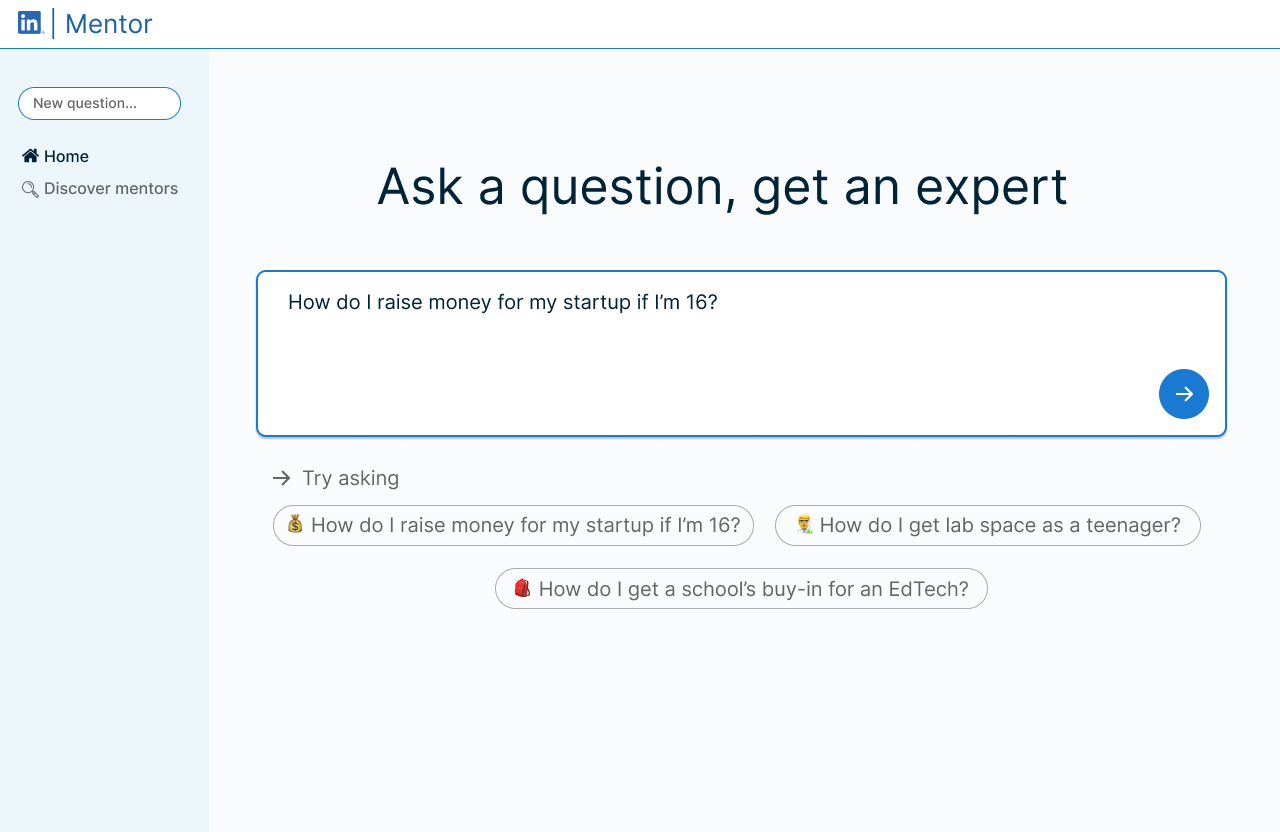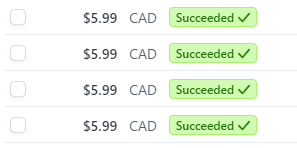Building a Product for LinkedIn, First Paying Beta Users, and Bringing Out Children’s Curiosity
Spent February exploring new ideas, learning from our first paying beta users, and understanding how curiosity works.
I came up with this line after February:
“Do whatever makes you feel alive.”
This is the story of how I got there.
Highlights of this issue:
Building LinkedIn Mentor: world’s best search engine for experts
What I learned from launching Aceflow with our first paying beta users
Revealing children’s innate curiosity with an AI children’s toy / my first TEDx talk
Raising $2k for a trip to SF this month
I’m Krishiv—here’s a quick refresher on me 👋
I’m a 15-year-old from Toronto passionate about disrupting education with emerging technologies. Founded Aceflow.org (beta), spoke about AI for education at places like Microsoft Canada’s HQ, and currently building an AI children’s toy to bring out children’s innate curiosity. When people ask me how I’m balancing high school with this journey, I say it’s because I’m obsessed—global human potential is on the line, and I get to help.
How to Do What Makes You Feel Alive
In my January newsletter, I wrote about following curiosity above all.
I’ve never felt more fulfilled, so I spent February doing the same thing. I think this is how I want to live my life.
I tried understanding the root cause of why I want to follow my curiosities so badly and ignore everything else. What I found is that I’m on a quest to feel the most alive I possibly can.
A lot of people are existing; few are actually living.
To me, feeling alive means finding joyful fulfillment in the experience of life, and I don’t think you can get there by doing things for others or seeking external validation, because if you do that, you’re living for someone else’s life, not your own.
Here’s a thought experiment for anyone who wants to start doing whatever makes them feel alive: Imagine you had unlimited resources and no obligations or responsibilities to anyone else. How would you choose to spend your days?
If you have an answer, let me know—I’d love to hear it!
Designing LinkedIn Mentor: The Best Search Engine For Experts
My friend
and I realized LinkedIn is sitting on a massive opportunity to accelerate the next generation of professionals.They’ve been shipping AI features, like one that generates takeaways from a LinkedIn post, but LinkedIn could be doing so much more with the unique data they have.
So we came up with LinkedIn Mentor—ask a question, get an expert. If I ask, “how do I raise money for my startup as a 16-year-old?” I’ll get the most relevant LinkedIn profiles (ideally people who raised money for their startups at age 16) and can then send them a message.
Currently working on pitching LinkedIn on building and implementing this. The technicals work to make this feasible—just need to leverage LLMs and RAG—and that’s what makes this so exciting.
You can check out our case study on LinkedIn Mentor here, with our interactive design prototype, technical feasibility breakdown, and more.
What I Learned From Launching Aceflow With Our First Paying Beta Users
Key takeaway: Stripe notifications get addicting.
But for real, I reflected a bunch on this to give you some fresh insights. If you’re curious about building products/starting a startup, these 2 insights might help:
Your beta should be paying users because they actually have skin in the game
I let our beta users use Aceflow for free for too long. It was a huge challenge. Truth is, virtually anyone would sign up for anything for free. It’s not a clear indication of whether you’ve built something of major value. I had to follow up constantly with beta users, some of who weren’t using the product actively, probably because they weren’t paying. If they were paying, they’d feel like they’re not getting their money’s worth if they don’t actually use the product—it’s like buying a gym membership.
I see this happen a lot with AI products that are just simple wrappers on a foundational models—if your AI product is just slightly better for its specific use-case than ChatGPT, getting free users will be easy, but getting paying users will be hard. You might have a product, but you won’t have a business.
Free users don’t mean you built a 10x product
People who can pay for things they want will pay for things they want. I strongly believe that in D2C software, users will pay for your product if it’s 10x better than the status quo—even in social media, where the customers are advertisers, and the service being free for users is a standard. If someone built a 10x Twitter, users themselves would be willing to pay. That’s why so many people are starting to subscribe to Twitter’s Premium subscription—the subscription gives you features that make building an audience on Twitter way easier. Even Telegram (it’s an app like WhatsApp) has over 1 million paying subscribers. If users aren’t paying for your product, chances are it’s only 10% better than the status quo, and your target market would rather just save money than get a little bit of benefit instead.
Bringing Out Children’s Innate Curiosity With an AI Children’s Toy
We’re born into a world we don’t fully understand.
That’s why kids ask “why?” all the time—it’s their way of seeking to understand what they are seeing or experiencing.
It’s hard for parents to have to constantly answer those questions all the time—and sometimes they don’t know the answer. I still remember when I first asked my parents why the sky is blue.
And the traditional education system doesn’t seem welcoming to these curious young minds either—whenever I ask a teacher about something more advanced than the course’s curriculum, the teacher’s response is always, “you’ll learn about it in Grade 11.”
The world we live in is killing children’s curiosities. I want to build something that nurtures children’s curiosities.
That’s why I’m building an AI children’s toy designed to nurture curiosity and help design a fulfilling life.
Recently I had the chance to meet
, the CEO of rebelEducator. I asked her what she thought the best education system would look like, and she said it wouldn’t be a system.Systems drive you towards an outcome. But people in a system might not want its outcome, and don’t realize it because they’re surrounded by people running towards that outcome without anyone stopping to wonder why. It gets accepted as a truth.
If I build the tool that gives children self-awareness on what they’re most curious about spending their life on, I could help people drive towards their own outcomes.
Keeping this on the low for now, but stoked to present about the project at TEDxVail Youth in April—using my first TEDx talk as a forcing function to make as much progress on this as possible!
Raising $2K for a Trip to SF This Month
Open the door first, figure out how to walk into the room later.
Last month, I got accepted as the only non-university student for the Stanford ASES Summit while still being in high school. But travelling from Toronto to SF costs money.
Wrote a strong application for Inflection Grants on how having the money to go to SF for a week for the summit could disrupt my life trajectory. Got an email a few days later for $2k to cover my expenses.
I remember being 8 years old reading a book about entrepreneurship, dreaming about going to Silicon Valley some day. I’m lucky to have learned early that dreaming won’t take you anywhere unless you act. You can be ambitious, but if you’re not doing something different from everyone else, how would you achieve your ambitions?
My favourite quote on this topic is from my mentor Nadeem Nathoo:
“The only way to achieve unconventional success is to follow an unconventional path. You can’t expect to do the same thing as everyone else and achieve a different result.”
What’s happening in March?
Going to SF for the first time for the Stanford ASES Summit
Planning how to pitch a nuclear fusion company in-person on a hackathon project I built with my friends Rayan and Sasha that could accelerate the industry
Launching Aceflow publicly
Building a functional v1 of my AI curiosity-igniter children’s toy
Thanks for reading! I would super appreciate you sharing this newsletter with anyone you think would find me or this issue interesting. Reply to this post and I’ll get back to you!






Great read Krishiv, best of luck on all your endeavours and for SF.